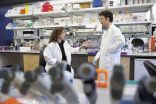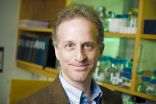(Press-News.org) Senescent cells have a bad-guy reputation when it comes to aging. While cellular senescence - a process whereby cells permanently lose the ability to divide when they are stressed - suppresses cancer by halting the growth of premalignant cells, it is also suspected of driving the aging process. Senescent cells, which accumulate over time, release a continual cascade of inflammatory cytokines, chemokines, growth factors and proteases. It is a process that sets up the surrounding tissue for a host of maladies including arthritis, atherosclerosis and late life cancer. But in a study publishing online in advance of the December 22nd edition of Developmental Cell, Buck Institute faculty Judith Campisi, PhD, postdoctoral fellow Marco Demaria, PhD and colleagues show that senescent cells act as good-guys when it comes to wound healing. Moreover, they identified a single factor secreted by senescent cells that cause them to promote wound healing. It's a crucial discovery for researchers (including Campisi) who are working on developing treatments to clear the body of senescent cells as a way to stem the development of age-related disease.
"What is most exciting is that we are now able to identify what senescent cells express that makes them beneficial," said Campisi, senior scientist on the study. "This means we will be able to simply provide that factor while we eliminate senescent cells to prevent a deleterious side effect before it even occurs."
Postdoctoral fellow, Marco Demaria, PhD, lead author of the study, used two different mouse models: in the first, which was developed in collaboration with colleagues at the Erasmus, Harvard and Einstein Medical Schools, senescent cells can be visualized and eliminated in living animals; in the second, which was developed by Eiji Hara, Naoko Ohtani and colleagues at the Japanese Foundation for Cancer Research, mutations in two key genes block the senescence program. Demario showed that following a skin wound, senescence occurs early on in cells that produce collagen and line blood vessels. Demaria said the senescent cells accelerated wound closure through the secretion of PDGF-AA, a growth factor contained within blood platelets, making it the "good guy" in this portrayal of senescence. "We were able to apply recombinant PDGF-AA topically to mice that had senescent-free wounds," said Demaria. "It rescued delayed wound closure and allowed the mice to heal normally."
The researchers also found that senescent cells were present only for a short time during tissue repair, in contrast to the persistent presence of senescent cells in aged or chronically damaged tissues. Moreover, they say the fact that PDGF-AA was activated very early upon senescence induction in cell culture suggests the time-dependent regulation of secretory factors might, in part, explain the beneficial vs. deleterious effects of senescent cells.
Campisi says the finding shows that, in addition to preventing cancer in the young, cellular senescence might play a beneficial role in human health, perhaps throughout the entire lifespan. "It is essential that we understand the full impact of senescence," Campisi said. "The possibility of eliminating senescent cells holds great promise and is one of the most exciting avenues currently being explored in efforts to extend healthspan. This study shows that we can likely harness the positive aspects of senescence to ensure that future treatments truly do no harm." The researchers now plan to explore the role of senescent cells in other examples of tissue injury.
INFORMATION:
This work was supported by grants from the American Italian Cancer Foundation, the Japan Science and Technology Agency, the US National Institutes of Health (AG017242, AG009909 and AG041122), and a European Council Advanced Grant. The authors declare no conflicts of interests.
Other contributors include: Francis Rodier and Remi-Martin Laberge from the Buck Institute; Naoko Ohtani and Eiji Hara, Division of Cancer Biology, The Japanese Foundation for Cancer Research, Koto-ku, Tokyo; Sameh A. Youssef and Alain de Bruin, Dutch Molecular Pathology Center, Department of Pathobiology, Faculty of Veterinary Medicine, Utrecht University, The Netherlands; Wendy Toussaint, James R. Mitchell and Jan H. J. Hoeijmakers, CGS Department of Genetics, Erasmus Medical Center, Rotterdam, The Netherlands; Jan Vijg, Department of Genetics, Albert Einstein College of Medicine, Bronx, NY; Harry Van Steeg, Department of Toxicogenetics, Leiden University Medical Center, Leiden, The Netherlands; Martijn E. T. Dollė, National Institute of Public Health and the Environment (RIVM), Bilthoven, The Netherlands.
About the Buck Institute for Research on Aging
The Buck Institute is the U.S.'s first independent research organization devoted to Geroscience - focused on the connection between normal aging and chronic disease. Based in Novato, CA, The Buck is dedicated to extending "Healthspan", the healthy years of human life and does so utilizing a unique interdisciplinary approach involving laboratories studying the mechanisms of aging and those focused on specific diseases. Buck scientists strive to discover new ways of detecting, preventing and treating age-related diseases such as Alzheimer's and Parkinson's, cancer, cardiovascular disease, macular degeneration, osteoporosis, diabetes and stroke. In their collaborative research, they are supported by the most recent developments in genomics, proteomics, bioinformatics and stem cell technologies. For more information: http://www.thebuck.org
The ascetic and moralizing movements that spawned the world's major religious traditions--Buddhism, Islam, Judaism, Hinduism, and Christianity--all arose around the same time in three different regions, and researchers reporting in the Cell Press journal Current Biology on December 11 have now devised a statistical model based on history and human psychology that helps to explain why. The emergence of world religions, they say, was triggered by the rising standards of living in the great civilizations of Eurasia.
"One implication is that world religions and secular spiritualities ...
EMBARGOED for release Thursday, Dec. 11, 2014, at 12 p.m. ET
HOUSTON - (Dec. 11, 2014) - The ancient Japanese art of origami is based on the idea that nearly any design - a crane, an insect, a samurai warrior - can be made by taking the same blank sheet of paper and folding it in different ways.
The human body faces a similar problem. The genome inside every cell of the body is identical, but the body needs each cell to be different -an immune cell fights off infection; a cone cell helps the eye detect light; the heart's myocytes must beat endlessly.
Appearing online ...
Clinical trials to test the new drugs in patients should begin as early as 2015.
Existing drugs target faulty versions of a protein called BRAF which drives about half of all melanomas, but while initially very effective, the cancers almost always become resistant to treatment within a year.
The new drugs - called panRAF inhibitors - could be effective in patients with melanoma who have developed resistance to BRAF inhibitors.
The new study was funded by the Wellcome Trust and Cancer Research UK, and jointly led by scientists at The Institute of Cancer Research, ...
Scientists at the University of Southampton have found that the precise shape of an antibody makes a big difference to how it can stimulate the body's immune system to fight cancer, paving the way for much more effective treatments.
The latest types of treatment for cancer are designed to switch on the immune system, allowing the patient's own immune cells to attack and kill cancerous cells, when normally the immune cells would lie dormant.
In a study, funded by Cancer Research UK and published in the journal Cancer Cell, the Southampton team have found that a particular ...
PHILADELPHIA - (Dec. 11, 2014) - A team of scientists, led by researchers at The Wistar Institute, has found that an infection with herpes simplex virus 1 (HSV-1) causes rearrangements in telomeres, small stretches of DNA that serve as protective ends to chromosomes. The findings, which will be published in the Dec. 24 edition of the journal Cell Reports, show that this manipulation of telomeres may explain how viruses like herpes are able to successfully replicate while also revealing more about the protective role that telomeres play against other viruses.
"We know ...
The saga of the Osedax "bone-eating" worms began 12 years ago, with the first discovery of these deep-sea creatures that feast on the bones of dead animals. The Osedax story grew even stranger when researchers found that the large female worms contained harems of tiny dwarf males.
In a new study published in the Dec. 11 issue of Current Biology, marine biologist Greg Rouse at Scripps Institution of Oceanography at UC San Diego and his collaborators reported a new twist to the Osedax story, revealing an evolutionary oddity unlike any other in the animal kingdom. Rouse's ...
HOUSTON -- (Dec. 11, 2014) -- In a triumph for cell biology, researchers have assembled the first high-resolution, 3-D maps of entire folded genomes and found a structural basis for gene regulation -- a kind of "genomic origami" that allows the same genome to produce different types of cells. The research appears online today in Cell.
A central goal of the five-year project, which was carried out at Baylor College of Medicine, Rice University, the Broad Institute and Harvard University, was to identify the loops in the human genome. Loops form when two bits of DNA that ...
BUFFALO, N.Y. -- Some drugs used to treat diabetes mimic the behavior of a hormone that a University at Buffalo psychologist has learned controls fluid intake in subjects. The finding creates new awareness for diabetics who, by the nature of their disease, are already at risk for dehydration.
Derek Daniels' paper "Endogenous Glucagon-Like Peptide-1 Reduces Drinking Behavior and Is Differentially Engaged by Water and Food Intakes in Rats," co-authored with UB psychology graduate students Naomi J. McKay and Daniela L. Galante, appears in this month's edition of the Journal ...
London, United Kingdom, December 11, 2014 - Middle East respiratory syndrome coronavirus (MERS-CoV) is an emerging virus, with the first case reported in 2012. It exhibits a 40% fatality rate and over 97% of the cases have occurred in the Middle East. In three new studies in the current issue of the International Journal of Infectious Disease, researchers reported on clinical outcomes in the Kingdom of Saudi Arabia (KSA), how long patients will shed virus during their infections, and how the Sultanate of Oman is dealing with cases that have appeared there. An editorial ...
(MEMPHIS, Tenn. - December 11, 2014) Toddlers who undergo total body irradiation in preparation for bone marrow transplantation are at higher risk for a decline in IQ and may be candidates for stepped up interventions to preserve intellectual functioning, St. Jude Children's Research Hospital investigators reported. The findings appear in the current issue of the Journal of Clinical Oncology.
The results clarify the risk of intellectual decline faced by children, teenagers and young adults following bone marrow transplantation. The procedure is used for treatment of cancer ...


